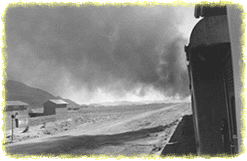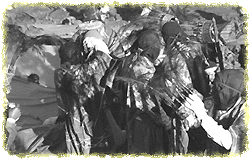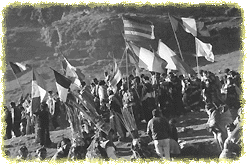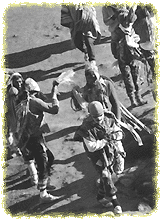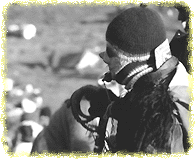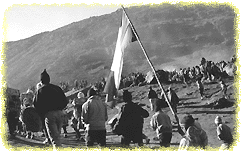 |
 |
 |
|
|||
|
There are so many rich layers to a country like Peru, that as a traveler it's hard to know where to begin. You can visit colonial cities, the streets and buildings which still maintain the history of the Spanish conquistadors. You can visit the ancient Incan capital of Cuzco or explore the lost city of Macchu Picchu. The Savvy Traveler's Sandy Tolan set out last month on a journey through the Andes with the intention of taking a walk back in time to the last days of the Incan Empire. But on his way toward the Inca trail, Sandy got way-laid, took a different turn, and, as happens so often in travel... went on a much more surprising journey.
The Incas knew the seasons, the weeks and the days, by the stars. They knew exactly where their sacred sun would fall each evening along the jagged horizon. Their buildings were made with stones that fit together so perfectly, they didn't need mortar: an earthquake couldn't budge them. Stones so large, no one to this day knows how they got there. High in the Andes, the Incas built thousands of miles of trails. Young men of the empire ran up and down the mountains in a relay, blowing shell horns to announce their arrival, carrying messages conveyed by knotted ropes. It was said they could bring fresh fish from the coast to the emporer in Cuzco in two days -- less time than it takes by bus or car today. I arrive here in an hour by jet. I sit by the fountain in Cuzco's Plaza de Armas, dizzy and disoriented from the altitude, sipping the antidote, coca leaf tea. Gazing sleepily at the great Spanish cathedral, I think about Francisco Pizarro and his band of violent explorers. In 1532, this force of 160 men, with their swords and armor and horses, conquered Chief Atahualpa and his Incan army of 40 thousand. Pizarro promised to spare the Inca in exchange for a room filled with gold; the Spaniards smashed the ransom, delicate golden figurines, to pieces, so they could squeeze more gold into the room. Then they killed Atahualpa. Thereafter, all the subjects of the Incan empire belonged to the Spanish crown, and to a new god. The conquest by the Spaniards, and the "civilization" of the Indians by the Catholic church, would go hand in hand. A boy on the Plaza is selling slices of his mother's orange cake. Like the many sidewalk vendors with their sweaters and pottery and stuffed toy llamas, he's come down from the hills above Cuzco before dawn.
The boy tells me, here you can talk to lots of people, tour companies, they'll take you anywhere. But as I talk with the tourist agencies that crowd along the Plaza, I learn about another trail, far from Macchu Picchu...one, it's said, that was walked for centuries before the Spaniards came...one that's still used today. A trail not of something lost, but of something living: the annual festival of Qoyllur Riti, an Andean religious pilgrammage at 16,000 feet, its roots in the Incan empire. I hear warnings: the road is rough, the hike steep and exausting, nights in a tent below freezing, the experience raw and overwhelming -- but also, I'm promised, astonishing -- if you go with respect. We ride out of Cuzco at ten o'clock on a deceptively warm evening, the Plaza calm under a plump yellow moon. This microbus is supposed to fit twenty, but we pilgrims are twice that many, cramming in for an overnight ride they say will take seven hours.
My knees bang against the seat in front of me. My arms are wedged between my compatriots. As the bus careens down potholed dirt roads, our rear ends hammer the seats like pistons. This doesn't stop my German friend from falling asleep on my right shoulder, nor the Peruvian, on my left shoulder... as I become an international sleep rest. It seems this could go on all night. I look out at the road before us, framed in a pool of light. From this seat, at this moment, our destination seems impossibly distant. Still, I think, that this trip is not supposed to be easy, that the cost of the trip -- 45 dollars for two nights of camping, food, tour guide -- isn't the real price. That somehow the difficulty of the journey must be related to what lies at the end, at 16,000 feet.
Back on the road: we ride through the night, rattling down into valleys, climbing back up the Cordillera of the Andes. As the bus snakes its way through the dark, churning up black dust, carrying its load of tourists from Italy and Germany and America and Peru, another pilgrammage is well under way: naciones, or groups of pilgrims, making their own way to Qoyllur Riti. Thousands of Andeans from hundreds of villages are crossing the mountains on foot, or by horseback, or jammed into flatbed trucks or microbuses like ours, heading toward the shrines in the mountains. Dawn greets us with a flat tire. We're at 14,000 feet. The air is thin, here above the treeline, the land pale yellow, rocky, dusted with frost. Far below, a house, a stone fence, a few llamas, a potato patch. Nothing else grows at this altitude. Very spare here, like the cold, clear light that makes the distant ridge so sharp. There, just below the snow, lies our destination, and the steep trail up the mountainside. We can almost see it. A line of pilgrims moves through the steep hills, laden with sleeping rolls and blankets. The hill is awash in color -- black and red and yellow and green, from the intricate weave of shirts and sweaters and caps, each distinct to its own village. At the head of one group, a man carries a staff, draped by a headdress of macaw feathers... Following, women in red shawls and bowler hats, pots and pans slung on their backs. Then a man carrying the nacion's icon -- a wooden shrine of jesus surrounded by native dancers. And then the band, wooden flutes and drums, and trumpets glinting in the late morning sun. Feliciano: "Yes. In four days, hundred thousand people." Feliciano, our guide, says we are witness to one of the biggest religious pPilgrammages in the Andes. The Incas santuary, the snow, the sacred mountain.....this is the silver door. This is the Cordillera de Ausangate. Kollor'iti. This is the star. The riti this is the snow. This is the snow star. As we labor up the mountainside, Feliciano struggles to explain in English:
The pilgrims also make indigenous offerings at these crosses -- seashells, coca leaves, bits of llama hide, burned and buried beside the crosses -- before moving on, up toward the glacier. We arrive at the base of the glacier -- sloping pale green valley below an oval of white. It's just really hard to describe what's going on here. Hills filled with people, dozens of bands playing. The hill across the valley seems to be crawling -- but it is people, thousands of people in movement, carrying their brass instruments and wooden flutes, spinning in circles of elaborate dance, and pitching tarps and tents, making the mountain a speckled plastic blue. It's like the mountain is breathing, alive. At the center of the valley: a Catholic church, built upon a rock that is said to be an ancient Incan shrine. The spaniards placed the image of jesus here, declaring it a place of christian miracle. All around the hundreds of bands from across the peruvian andes play in cacaphonic tribute to both traditions.
For many, the heart of the worship lies in the journey of the bear-men, the Ukukus. And there they are, two of them, standing just below us. Young men dressed in black shag made to look like fur, white wool masks pulled over their faces, speaking in falsetto to hide their identity. The Ukukus are dancers, singers, clowns, policemen and heroes of koylloriti. In a few hours, at midnight, they will hike up to the glacier. Hundreds will go, carrying ice picks and whips made of rope, they will saw out chunks of the snowpack. This is the sacred water that moves from the Andes, all the way to the Amazon and out to the Atlantic, a journey of nearly four thousand miles. Here, above the headwaters this pilgrammage has been made for centuries, before the Spaniards, even before the Incas built their empire... Up in the glaciers, condemned spirits await the Ukukus. Naked, in chains, these Condenados are forever climbing the glaciers to seek salvation, forever slipping back down their eternal path of ice. Some Ukukus will do battle with the Condenado spirits, pirouetting on the slippery glacier, risking death at each step. We go in faith, these Ukukus say... Faith in Jesus, Faith in the Apus, Faith in the way that they will return -- even though, most every year, some do not. Vicente Revilla: Some Ukukus want to die. They want to be part of the glaciers....he's being part of the snow, part of the mountain. So there's a sad farewell around 12 oclock, and they hug eachother...when they're saying goodbye, basically they mean it. Because they don't know when they're going to come back. For those Ukukus, Vicente said, there would be no tears. they would become part of the glacier, part of God. We head back to our tent, to get ready for the approaching cold. June in the southern hemisphere means winter... and even though we're only 500 miles from the equator, at 15,000 feet, it will get below freezing tonight. Many years, the cold kills some of the youngest, covered only by bedrolls and plastic tarps.
We lie on our backs, staring up at our little blue ceiling.
Outside the tent, a full moon bathes the valley. The southern cross hangs like a jeweled crucifix in the sky. For the first time, I realize the Spanish didn't conquer on terms of religion, the Spaniards didn't win. In the end they couldn't control people's minds. The glacier stands silent and glowing, a thousand feet up. At its center, burning far above us, the lights of a Cathlolic shrine. Along the ridge, the Ukukus are surely making their way, with their ice picks, their rope whips and their prayers. Tuesday morning: stars mostly gone, moon disappeared, light breaking, hear the sounds of the mass coming from down below. And the first light of day is starting, the Ikukus should be coming down from the glacier by now. Vicente and I begin the half-hour trek to the base of the glacier. After a while, we look up to see a line of black, moving along the spine of the mountain. The bear men, the Ukukus are coming toward us now, in single file on the ridge, against the pale sky. On their backs I can see chunks of the glacier -- blocks of sacred ice -- some of it to be made into purifying barley tea, some given to the Catholic priests below for benediction...some to be hauled the hundred miles back to Cuzco, to be blessed by the cardinal. On the ride back to Cuzco, children lined the dusty roads, holding out their hands for anything -- a pair of socks, some batteries, a piece of candy, a scrap of bread -- that we more fortunate might throw from the windows. The driver was crazy, overtaking other buses on narrow mountain passes like he was immortal, nearly killing us all more than once. Who knows why he did that? Vicente said we were inside a kind of Andean fatalism. A microbus plunging over the side, he said, an Ukuku falling from a glacier -- death comes when it comes. It is a passage to something else. We who brush against it and survive are left to celebrate.
There, amidst the brass and confetti, the bear men end their journey, placing the chunks of a holy mountain at the steps of the cathedral.
|
 | American Public Media Home | Search | How to Listen ©2004 American Public Media | Terms of Use | Privacy Policy |


